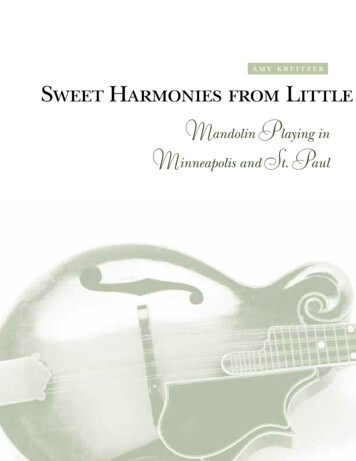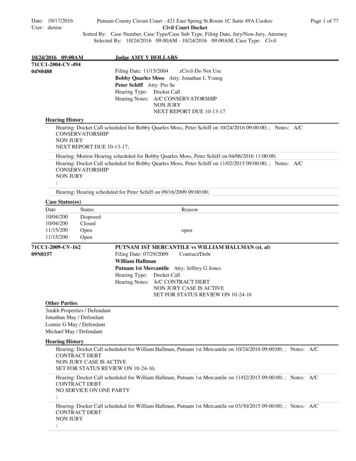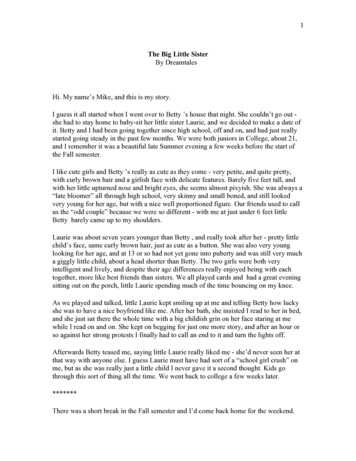
Transcription
amy kreitzerSweet Harmonies from LittleMandolin Playing inMinneapolis and St. Paul
Wooden BoxesAt the close of the nineteenthcentury, a new and distinctive soundcaught the ears of Minnesotans ranging from poor Italian immigrants toaffluent young men. The captivatingsound came from a small, eightstringed wooden instrument called themandolin. While modern listenersassociate it with bluegrass and folkmusic, a hundred years ago mandolinswere welcomed in the realms of classical and popular music.Between 1890 and 1920, the goldenage of the mandolin, traveling concertThe Albert Bellson Mandolin Quartet, late 1930s:(clockwise from lower left) Bellson and WallaceZiebarth with mandolins, Clifton Peterson withmandocello, and Vergel Vanzora with mandola219
artists, vaudeville performers, andlocal teachers inspired thousands ofamateur musicians around the country to takeup the instrument. Forming mandolin clubs, themusicians made warm, mellow sounds together forappreciative and enthusiastic listeners. As the decadespassed, orchestral ensembles, including guitars andother fretted instruments, entertained listeners at largeconcerts and on the radio. By the 1940s, however, musical tastes had changed, and amateur music making hadtaken a back seat to other, more passive entertainments.The era of the mandolin drew to a close.1While mandolin clubs thrived for a time in Minnesota cities including Brainerd, Stillwater, Mankato, ElkRiver, Spring Valley, and St. Cloud, Minneapolis andSt. Paul were the vital hub of mandolin playing in theUpper Midwest. They boasted professional mandolinists, a few of them of national reputation, and hosts ofamateur players. Schools offered instruction, and manylocal businesses catered to players by selling instruments, strings, and music. Minneapolis was even hometo a handful of mandolin makers.2From the late 1880s to the 1940s, more than 50mandolin ensembles flourished in the Twin Cities, including women’s, men’s, children’s, and mixed groups.Their repertoire included opera arrangements, marches,overtures, waltzes, two-steps, galops, mazurkas, polkas,quadrilles, character pieces, and programmatic works.Ensembles performed in homes, churches, parks,opera houses, lakeside hotels, and amusement parks,to name a few venues. They played for events includingreceptions, weddings, and socials. The Aeolian Mandolin Orchestra even played over the telephone, givinga concert in 1900 to friends in Minneapolis, Anoka,Buffalo, and Wahpeton, North Dakota.3The mandolin originated in Italy in the eighteenth century. Although there were several regionalvariants, the design codified by the Vinaccia family ofNaples became most common.4 This Neapolitan mandolin has eight strings grouped in four pairs and tunedin fifths to the same pitches as the violin (g-d′-a′-e″ ).Amy Kreitzer is a librarian and assistant professor at the Collegeof St. Catherine, St. Paul. She has previously written about thehistory of English flutes in The Galpin Society Journal.220MINNESOTA HISTORYA round-back Italian mandolin, advertised for 25 in aP. Benson Musical Merchandise catalog, 1912Unlike violins, however, mandolinfingerboards have metal frets,and players activate stringswith a pick or plectrumrather than a bow. Becausethe resulting sound decaysrapidly, players sustain tonesby a rapid up-and-down plectrum motion, a techniquecalled tremolo.Until about 1910, most Italian mandolins had rounded backs made from thin strips ofwood, called ribs. High-quality instruments might havemore than 40 ribs as well as lavish decoration in ebonyand mother of pearl. Mandolin tops were flat with anangle just below the bridge.During the 1890s several American companiesbegan crafting mandolins. The largest, Lyon & HealyCompany of Chicago, manufactured the popularWashburn line, by 1894 producing more than 7,000mandolins a year. In the same year Orville Gibson, aninstrument maker in Kalamazoo, Michigan, began radically redesigning the instrument by applying principlesfrom violin construction. Instead of bending strips ofwood to create a bowl or pear-shaped back, he carvedthe back and top out of single, thin pieces of wood.These new mandolins had a bigger, louder sound.Some models had asymmetrical, Art Nouveau-inspiredshapes and decorative curlicues. By the 1910s theGibson Mandolin-Guitar Company aggressively marketed a whole family of mandolins in different sizes—mandolins, mandolas, mandocellos, and even mandobasses. While many other styles existed, most Minnesota mandolinists played either traditional round-backor Gibson-style instruments.5The mandolin’s popularity stemmed in part fromthe ease with which it could be learned. Beginnerscould acquire basic techniques fairly rapidly. In addition, mandolins could be purchased from local dealersfor less than 10 in the 1890s, and lessons were inexpensive. Mandolins were portable and easily taken onoutings and vacations. Some people reportedly carriedmandolin cases simply to appear stylish. Because man-
dolins could be played in ensembles, they offeredsocial advantages as well. One 1930s advertisement,for example, promised players “good times, popularity,companionship, travel and education.”6The event that set off the national mandolin crazein the United States was a visit in 1880 by the FigaroSpanish Students, a troupe of about 20 young menfrom Madrid who played bandurrias and guitars.Although the bandurria and the mandolin are not verysimilar—the guitar-like bandurria has 14 gut stringstuned in fourths instead of fifths—most Americans, whohad never seen a mandolin, assumed the bandurriaswere mandolins. The highly entertaining SpanishStudents, who wore exotic costumes and played fromPortability and ease of learning helped make the mandolinpopular (photo ca. 1910).memory with impeccable technique, toured both Northand South America, creating a sensation wherever theywent. Noticing their success, an enterprising New Yorker named Carlo Curti recruited some fellow Italian violinists to form their own Spanish Student group. TheseItalians, however, played mandolins because the instruments were much easier to obtain and the tuning wasfamiliar. Furthermore, American audiences failed tonotice the difference. Other counterfeit groups soonfollowed, and in this way America acquired its first generation of professional mandolinists.7Minneapolis was visited by at least one SpanishStudent company in October 1891, when a groupadvertised as “the World Renowned Spanish StudentsFrom the Royal Conservatoire, Madrid” and a Spanishdancer named Carmencita played at the Grand OperaHouse. According to the Minneapolis Tribune, “This feature proved entertaining by reason of its novelty andthe excellence of the playing. . . . The students playedCarmencita’s music, too, which was played with theexpression peculiar to Spaniards, and which, of course,added much to the effect.”8Three resident Italian immigrants contributed tothe growing popularity of the mandolin in the TwinCities. The earliest was Anacleto Montanelli, a mandolin teacher who arrived in Minneapolis in about1887. He opened a mandolin and guitar studio onNicollet Avenue, where he also sold and repaired theinstruments. The following year, Montanelli foundedthe Minneapolis Mandolin and Guitar Club, the area’sfirst. It debuted on March 31, 1888, at an Apollo GleeClub concert at the Grand Opera House. Before apacked house members played three pieces on sevenmandolins and two guitars.9Two months later, Montanelli’s club put on its ownconcert at Harmonia Hall in Minneapolis, playing aSuppé overture, two marches, and a Spanish waltz. Anewspaper reviewer described his impressions: “It wasan entirely novel and unusual entertainment. . . . Themandolin is an instrument little known in this country,but in the hands of an expert produces a very fine, fascinating kind of music, simple and having strict limitations but possessing a peculiar charm.” The next year,Montanelli’s club admitted six women members andgave a concert described as “one of the most successfulhome talent concerts of the season.” It also gave a performance at the Lake Harriet band shell, billed as aSPRING 2001221
women’s group, according to one newsitem: “Century Hall was well filled lastevening in compliment to Gino L.Perera and his mandolin clubs . . . andit was a pleasing success. The Ladies’Club . . . is composed of a dozen ormore well known ladies, and in a concerted number with the FlorentineClub they acquitted themselves withcredit as mandolin players.”11During the Minneapolis SummerCarnival of 1893, one of Perera’s clubsappeared in two concerts with the JohnPhilip Sousa Band, playing a Spanishfolksong as part of the grand finale,which was a Sousa composition calledSalute of the Nations to the ColumbianExposition. According to the Minneapolis Tribune, “The Salute opened withGino Perera popularized the mandolin asthe blast of trumpets and rattle ofa teacher and director of several clubs,drumsto proclaim the anniversary ofincluding the University of Minnesota’sthe discovery of America, rapidly fol1899 Mandolin and Guitar Club.lowed by different national airs, inwhich the band, [a 900-voice] chorus,and incidentally a fife and drum corps,Perera’s group of mandolin players,“Grand Sacred Concert, Vocal andand two bag pipers played a part.”Instrumental, by Signor Vegara, Assisted(One wonders how the mandolinsby Signor Montanelli’s Celebratedcould be heard above the din.) AlVenetian Mandolin Orchestra.” In Julythough Perera moved to Brussels,Montanelli played at a less sublimeBelgium, in about 1900, by 1904 hevenue: Minneapolis’s Dime Museum,had returned to Minneapolis wherewhere people viewed curiosities suchAdvertisement forhedirected the Central High Schoolas eight-footed horses and fighting kanCarmencita and a group ofMandolin Club and the Perera Mandogaroos. Perhaps Montanelli went on toSpanish Studentlin Club. After 1905, like Montanelli,a career on the vaudeville circuit, sincemandolinists (Minneapolishe disappeared from the Minneapolishe seems to have left the area by 1890.10Tribune, Oct. 18, 1891)scene.12Another Italian who popularized theIn 1883 a third Italian mandolinist,mandolin in the Twin Cities was Gino L.Tomaso (Thomas) Di Giorgio, arrivedPerera, who may also have been thein Minneapolis to stay, becoming aItalian consul in Minneapolis. In thetheater musician, composer, arranger, and teacher of1890s he taught mandolin and guitar at a studio onmandolin and guitar. During the late 1890s he directedNicollet Avenue and at St. Joseph’s Academy, a schoolthe 21-member Flour City Mandolin Club, which,operated by the Sisters of St. Joseph on Marshallaccording to the Minneapolis Journal, had “an extensiveAvenue in St. Paul. Perera directed several mandolinrepertoire of high-grade music” and was “one of thegroups, including one that was part of Minneapolis’smost popular and capable musical organizations of theFilharmonix Club, an ambitious amateur musical socicity.” A 1902 concert of Di Giorgio’s Dilettanti Mandoety that hosted a glee club, string orchestra, and banjolin Orchestra was noted this way in The Cadenza, one ofgroup. He also directed other ensembles, including a222MINNESOTA HISTORY
The long-lived Twin City Mandolin Club, including a 12-stringed mandolin, guitar, and violin, about 1900the nation’s foremost fretted-instrument periodicals:“The listener is charmed by the evident musicianlyevenness of its members and impressed by the influence of its director. Their work throughout was coloredby a warm southern expression . . . a graceful, emotional understanding of each selection that was thoroughlyhuman.” Di Giorgio directed a mandolin orchestra aslate as the 1920s, and his wife Laurentina and daughter Fortunata were also players and members of thelocal musicians’ union.13Sharing credit for popularizing the mandolin inMinneapolis was Charles Shibley from Oswego, NewYork. He taught a wider variety of instruments thanthe Italians, also being skilled on the banjo, guitar,and zither. This versatility enabled him to direct manyfretted-instrument clubs during the 1890s, includingthe Hollow Cove Banjo Club, Concert Banjo Club,Crescent Banjo Club, Alpine Zither Club, FlorentineMandolin Club, and Florentine Mandolin Sextet.Eventually, Shibley joined the faculty of the MacPhailSchool of Music, and by 1914 he had married one ofhis students, Catherine Salter, with whom he taughtuntil his death in 1931. Catherine continued at MacPhail until about 1947 and taught fretted instrumentsin her home until 1968. The couple’s careers in Minneapolis thus spanned nearly 80 years.14Although mandolin clubs caught on slowly inSt. Paul, its first group, the Twin City Mandolin andGuitar Club, was one of the state’s longest-lived. Thegroup’s earliest surviving program is from an 1891 concert at the English Lutheran Church of the Redeemer,where the club performed the “Skater’s Waltz” and aselection from Verdi’s Il Trovatore on a bill with the IdealBanjo Orchestra, a zither soloist, and other musicians.15The club’s most prominent members were cofounders Frederick Swanson and Anthony L. Snyder.Swanson, a native of Red Wing, taught mandolin andSPRING 2001223
guitar in St. Paul, directed the Twin City MandolinClub until 1906, and composed and published sheetmusic, including the very popular “Minnesota StreetRag March” (1903). Snyder played the banjo in vaudeville before moving to St. Paul in 1879, where hetaught mandolin, banjo, and guitar and directed theElk’s Banjo Club. When Swanson gave up directing theTwin City club, Snyder took it over until it disbandedin 1924.16A much shorter-lived St. Paul club was the Collegeof St. Thomas Mandolin and Guitar Orchestra. Itsdirector was John Ryder, a teacher of fretted instruments and the director of Ryder’s Mandolin Orchestra.Playing first mandolin was a man of the cloth—theRev. John Lowry, a prefect at the college. At its largestin 1896 with 10 mandolins, four guitars, a violin, flute,banjo, and piano,
SPRING2001 221 dolinscouldbeplayedinensembles,theyoffered socialadvantagesaswell.One1930 sadvertisement, forexample,promisedplayers“goodtimes,popularity,











